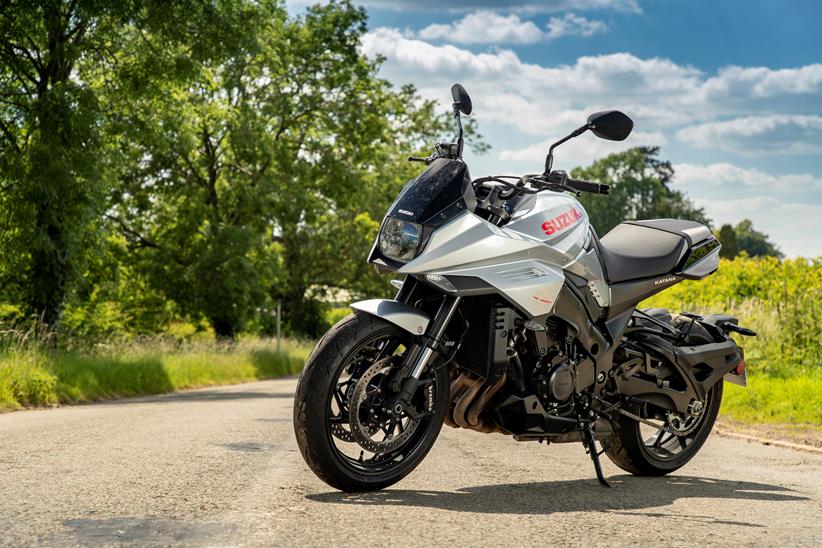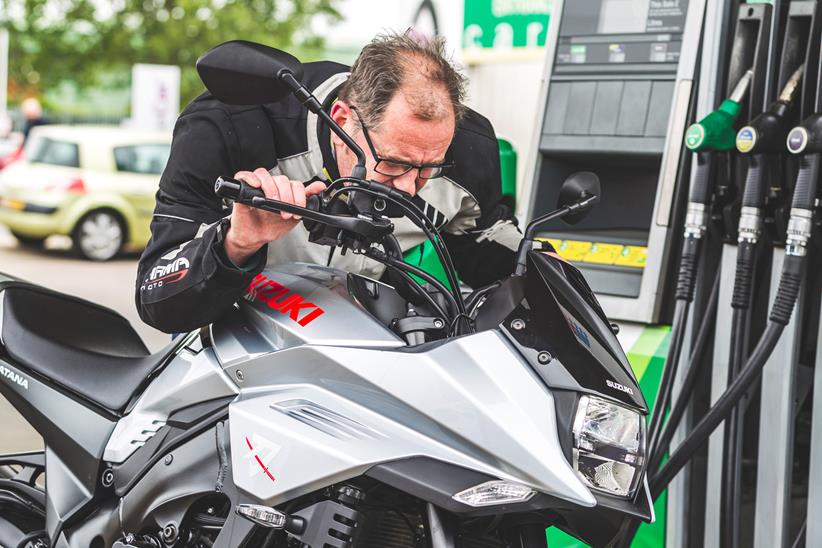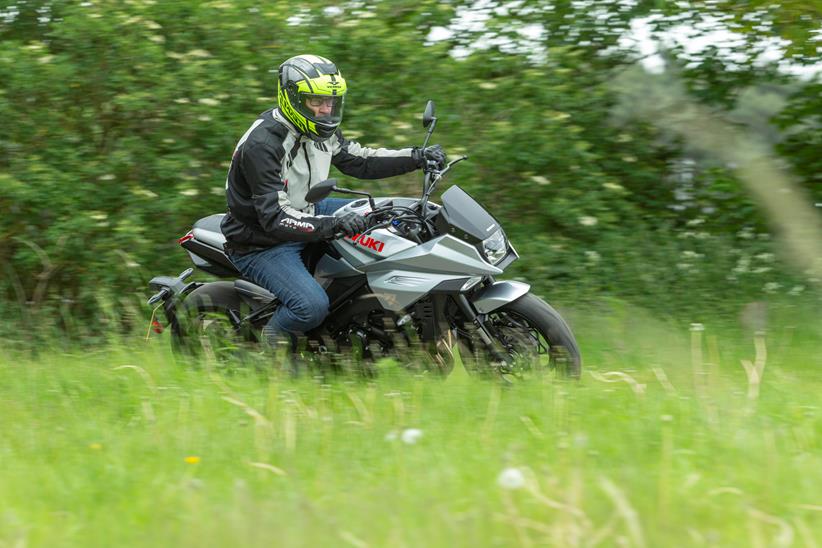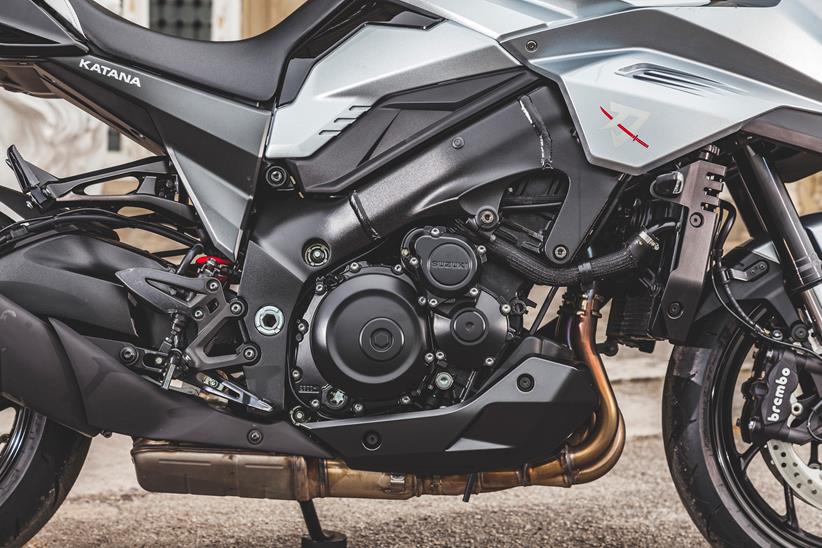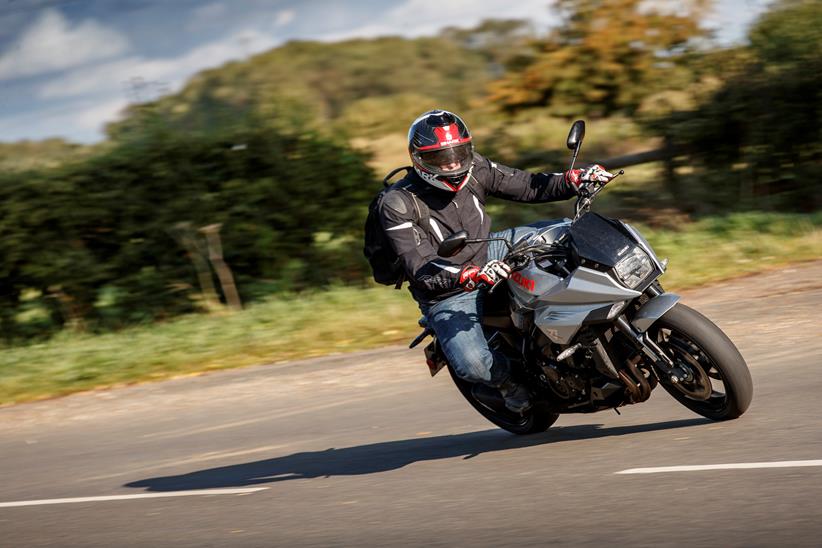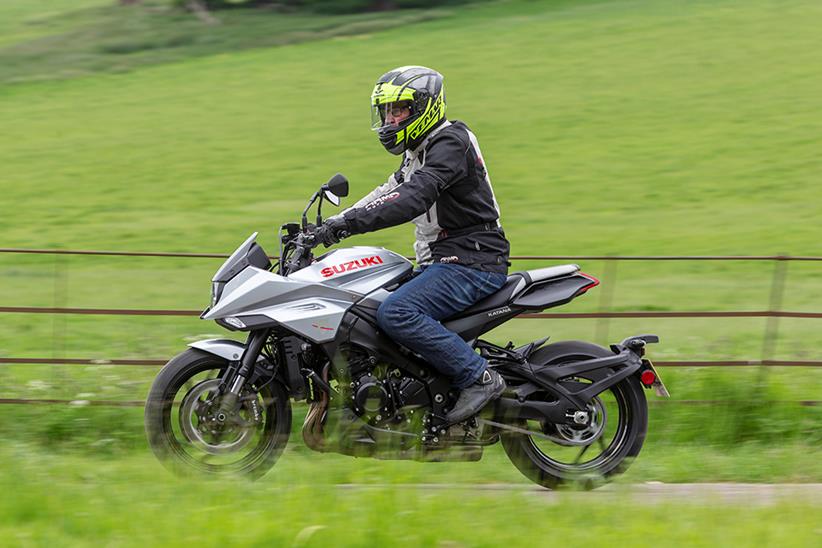MCN Fleet: A grand off the Suzuki Katana could prove tempting
Suzuki somewhat jumped on the bandwagon with the 2019 Katana having no doubt seen the success of the Kawasaki Z900RS.
Take a tried and tested road bike, in this case the Suzuki GSX-S1000, give it a restyle and a name that taps into fond memories of the ‘good old days’ and away we go. Only many feared, after seeing it at various shows and from early test reports, that Suzuki hadn’t gone far enough and at £11,399 (a Z900RS is £10,199), it was too steamy for some .
I liked the looks of the new Suzuki Katana and wasn’t too worried about how authentic its links to the original were. I was a bit too young (honest guv’nor) to have that particular rulebook ripper-upper adorning my bedroom wall as a teenager .
1076 miles
After two months and 1000 miles, Suzuki’s angular Katana had won me over with its in-your-face styling and stonking Suzuki GSX-R1000 K5 engine .
It’s not perfect, of course, but on everyday rides on everyday roads, it delivers plenty of guts and grunt to be properly smile-inducing. It’s fairly comfortable, too, although two hours in the saddle is enough, which is a good job really as it needs filling up at around the 120-mile mark .
Once stopped, be prepared to talk about the bike, too. Trips to the Super Sausage Café, near Silverstone, and Donington WSB in May, were met with a small crowd gathered around, all gawping at the big Kat.
![]()
2037 miles
Most of the time that incredibly small 12-litre tank is bearable. With a 120-mile tank range it’s rare that it becomes a proper pain. But when it does, it does. A 250-mile round trip becomes a two-stop strategy, which is annoying but no more than that.
Sunny summer days also highlighted readability issues with the dash. Even on its brightest (or dullest) setting the smaller bits of info (like the clock) simply aren’t readable in bright sunlight .
3917 miles
There are very few signs of wear and tear after nearly 4000 miles (other than those imposed upon it) and the stonking motor continues to serve up serious smiles. Overall, the Suzuki Katana is still in good nick, despite its recent road-metal interface (see update below)!
With the Katana now gone and the dust settled, the elephant in the room pokes me in the chest demanding an answer: “Would you buy one? Would you, really?”
I like the bike, the engine particularly, and I got upset when others claimed the Honda CB1000R was better. I don’t agree. But I don’t think the Katana justifies its £11,399 price tag. It either needs to be a grand cheaper or have high spec suspension and/or better equipment, such as an up and down quickshifter, rider modes and so on.
A Yamaha MT-07 is almost half the price and not half the bike. Although… Suzuki is currently doing a deal (until the end of January 2020) which sees £1000 taken off the asking price, so at £10,399 it’s tempting.
Suzuki Katana: The story so far
- Update 1: Introducing the Katana
- Update 2: First impressions
- Update 3: Riding fun on the Katana
- Update 4: Great engine, small tank
- Update 5: Katana victim of a crash
Update five: Kat’s costly slip-up
Published: 24.09.19
![]()
It’s all too easy to get stuck in a rut. To choose the same meal at your favourite restaurant every visit, to repeatedly buy the same make of jeans and to stick with the same brand of tyres.
Break that habit and there’s an element of risk involved. The reason you end up choosing the same thing more than once is not really because you’re lazy or lacking creativity (okay maybe it is sometimes… but I love a Katsu Curry!), but if you do what you’ve always done, you’ll get what you’ve always got.
So when the Suzuki Katana’s OE Dunlop Roadsport 2 tyres started showing signs of wear after 3500 miles I decided to put my head above the parapet and turn to something a little different.
Maxxis tyres seemed like a fine place to start. The SuperMaxx STs cost a wallet-friendly £150 (about £70 less than the Dunlops) and are generally regarded as a decent, hard-wearing sports touring tyre.
I was a little underwhelmed with the Dunlops and surprised by how quickly they showed signs of wear after only steady road use. So I decided to give the Maxxis tyres a try.
As well as turning my back on more popular tyre options I also made another schoolboy error and lent the Katana to a work colleague. Despite several warnings of how slippery the Maxxis can be during the scrubbing-in period, things went badly wrong.
A low-speed slide saw my red-faced workmate damage the right-hand side of the bike. He was at a loss to explain what happened and scuttled off hurriedly to get some replacement parts, including a lower frame cover, bar-end weight, front and starter idle cover.
That little lot came in at £250 and I also need to replace the exhaust shroud and small bottom fairing at some point as they have also been scuffed up. That will be another £500.
![]()
With over 300 miles now covered on the new rubber, they seem to be performing fine, although I’m wary of getting too gung-ho.
That slip-up aside, the Katana is powering through Autumn with aplomb. There are very few signs of wear and tear after nearly 4000 miles and the stonking motor continues to serve up serious smiles. The small tank can be a little annoying as more regular visits to top up are needed, but sensible riding sees MPG top 50 so it’s not as much of an issue as expected.
The clocks continue to frustrate though, as some of the info is just too small and even on the brightest setting, it can sometimes be hard to decipher various readouts. But overall, the Katana is still in good nick, despite its recent road-metal interface!
Update four: The Katana has a great engine but the tank’s too small
Published: 13.07.19
![]()
After three months and nearly 3000 miles, Suzuki’s angular Katana has won me over with its in-your-face styling and stonking GSX-R1000 K5 engine.
It’s not perfect, of course, but on everyday rides on everyday roads, it delivers plenty of guts and grunt to be properly smile-inducing. It’s fairly comfortable, too, although two hours in the saddle is enough.
And with few trinkets; there’s no autoblipper, quickshifter or any riding modes, nearly £11.5k seems a bit steamy. But, it delivers a growling, knuckle-whitening ride every time, while being flexible enough to filter through town traffic when necessary.
It’s done its job as a back-lane blaster and general workhorse well so far with few niggles, but now it’s time for some new tyres and maybe a trackday or two.
Fuel Tank – MISS
With just a 12 litre capacity and a grunty four-cylinder engine, this machine was never going to be a frugal fuel-sipper. That said, it’s not as bad as you’d think.
With a reasonable average of 50mpg, it’ll easily do 120 miles before petrol is needed. But on a bike that’s fairly comfortable and capable of cruising at a decent pace, it could do with a tank that’s two or three litres bigger.
Engine – HIT
Just because an engine was once quite good, it does not necessarily mean it will still be good in a different chassis and in a different time. But in this case, the Suzuki GSX-R1000 K5 motor is growling malevolence at its best. It makes a proper 147.5 bhp at the back wheel and can snarl its way from 3000rpm in top to the red line.
Suspension/handling – MISS
The Suzuki’s stiff and unrefined KYB front end is vague at low speeds (and in the wet) and a soft rear bounces so much under hard load that you have to drag the back brake through bends to keep things stable. Both are fully adjustable so softening the front rebound and firming up the rear helps a bit, but it’s still not great.
Comfort/wind protection – HIT
Having ridden some of the Katana’s closest rivals I reckon the Suzuki is better than many nakeds at deflecting a lot of bluster. I’m six foot and find the windblast predictable and, even at slightly spicy speeds, it’s manageable. It’s a naked, so it’s always going to take a bit of neck muscle, but it only gets properly painful at properly silly speeds.
Styling/authenticity – MISS
In a bid to rekindle the Muth-designed Katana of the 1980s, Suzuki just haven’t gone far enough. If you like the looks, you like the looks and I actually find them striking and different enough to work for me, but they are not really a faithful or particularly creative modern take on a fondly-remembered icon.
Where the Kawasaki Z900RS has true retro flavour, Suzuki have just whacked on a headlight cowl and some angular side fairings to the existing Suzuki GSX-S1000.
Dash and info – MISS
There’s a lot of info on the digital dash, but it’s pretty straightforward to navigate. No engine mode jiggery helps keep things simple, but it’s not always easy to see, even with the dash on its brightest setting.
The clock, in particular, is difficult to decipher. The miles-to-empty readout is pretty accurate though and when it once showed zero miles to empty, I squeezed in 11.5 litres, meaning only a half-a-litre was left in the tank, which equates to about 10 miles.
![]()
Update three: Top Kat makes me smile every time
Published: 19.05.19
![]()
So often the things you worry about before an event fail to materialise and the things you never even considered, become a major pain in the backside!
When I first saw the Suzuki Katana in the flesh at last year’s NEC Show I was impressed. Those angular looks, so reminiscent of the 1981 original and the brute of a 1000cc Suzuki GSX-R K5 engine oozed aggression and purpose.
But a 12-litre tank? Really? While I’m no long-distance motorcyclist, I can take a few hours in the saddle before needing a frothy Cappuccino and a full body massage. Also, due to my ability to make petrol disappear almost as soon as I’ve applied it, I feared the worst.
And yet, it’s not worked out like that. The ‘miles-to-go-til-empty’ readout seems pretty accurate and the bike’s averaging over 50mpg, which means a comfortable 125-130 miles to a tank. And if you do need to eke it out a bit, it’ll do 140 miles before requiring a top-up.
![]()
The seat is a little canted forwards and there’s some vibration through the seat so a leg-stretch after 130 miles is often welcome anyway. I’ve also found the wind protection to be better than expected, with the little screen doing just enough to lift the turbulence over my head. A go on the Katana’s main rival, the Honda CB1000R, instead left me feeling like I’d had my head in a tumble dryer.
The annoying niggles have been pretty few and far between, but the dash is hard to see in bright sunlight, even on the brightest setting, especially the clock.
The throttle is a little jerky lowdown in the revs, too, but this has only really been an issue when negotiating tight bends or roundabouts in the wet, when you just want a soft throttle to potter around.
The tyres are already showing some signs of wear and a replacement set will soon be sought. I’ll look into ways of improving the suspension as the front feels way too hard while the back is oh-so bouncy. The first 2500 miles have been fun and I love the characterful engine. I don’t think the big Kat is perfect but it makes me smile every time I ride it.
Update two: Suzuki’s big Kat show it’s claws
Published: 07.04.19
![]()
I couldn’t wait to get to grips with Suzuki’s new Katana and the day after I took ownership, I managed to get 120 or so miles under my belt.
My inital impressions were good. It’s a comfy, natural riding position with an easy stretch to the bars and although you feel a little canted forwards, my six-foot frame was easily accommodated. There’s power everywhere and it’ll pull from 3000rpm in sixth without hesitation.
It was a bright day and I struggled to read some of the smaller readouts on the dash until I worked out how to dial up the brightness to its fiercest setting. Getting to grips with the informative dash is fairly intuitive and after about 10 minutes of fiddling about I was ready to go.
A lack of vibes
Vibes are minimal and the mirrors offer a clear rearward view at all times. Much has been said about the donor bike’s low-down fuelling, but on my first 50 miles on lovely dry roads, I had no complaints. Suzuki claim to have adjusted the fuelling and I was happy with slow speed corners and fiddly turns.
It was only later in the day when the rain hit, that I noticed a slightly glitchy throttle when tackling horribly moist roundabouts at very sedate speeds. Then it felt a little jerky and added to my nervousness.
There are no riding modes, but four levels of Traction Control (including off), which is a shame on a bike costing nearly £11.5k.
It’s also no lightweight at 215kg (claimed kerb), but it flows through country lanes effortlessly and has plenty of punch coming out of corners thanks to its proven 148bhp motor. The low seat height (835mm) means getting both feet flat on the ground offers little effort and the wide bars make levering it about a doddle, too.
One of my main concerns about the bike before even slinging a leg over it was the meagre 12-litre fuel tank. There’s a ‘miles-to-go’ readout which adjust as you ride and seemed to suggest I’d get 110-120 miles to the tankful.
But I achieved just 41mpg, so anything over 100 miles would be a stretch. On the sort of riding I’ve done so far, that’s not been an issue but on longer hauls it could become annoying.
Beyond that the Katana is a capable motorcyle with plenty of grunt. Styling is obviously subjective, but I like the sharp looks and echoes of the past. I’ve seen another 2019 Katana with the Samurai kit bolted on (£1000), but I wasn’t too impressed with the aftermarket screen as it bolts over the old one and is only about an inch higher.
The Samurai kit also provides a red and black pillion seat, a carbon effect front mudgaurd and engine covers, a tank pad, wheel rim tape and some red decals on the top fairing and seat unit. Think I’ll hold fire on that for the moment.
Next steps are a trackday and taking the Katana around MCN’s 250-mile road test route so there should be plenty more to talk about soon.
Update one: Introducing the Suzuki Katana
Published: 24.04.19
![]()
Suzuki’s Katana was big and brash when it first broke the mould in 1980 and the re-make looks almost as avant-garde, even if it is essentially a Suzuki GSX-S1000 beneath the 80s-aping angular bodywork.
I can’t wait to see if the GSX-R1000 K5 derived engine does the legend justice or whether it’s a powerplant that was better left viewed through rose-tinted spectacles.
A trip down memory lane at the wonderful Suzuki museum in Hamamatsu today, ahead of the launch of the new Katana. Takes you back, doesn’t it? pic.twitter.com/EMPNnraszd
— Motor Cycle News (@MCNnews) March 12, 2019
I’m looking forward to taking it to a few race meetings to see what reception it gets from the old guard and younger riders alike, and I don’t doubt that the odd trackday may prove too tempting to resist.
And, of course, I’d love to find an owner of an original model and go for a blast together, swapping bikes to see if Suzuki have achieved something deeper than a simple lookalike.
- Key stats: • £11,399 • 147.5bhp • 80ftlb • 825mm seat • 215kg (kerb)
- Rider: Andy Calton (50, 6ft, 95kg)
